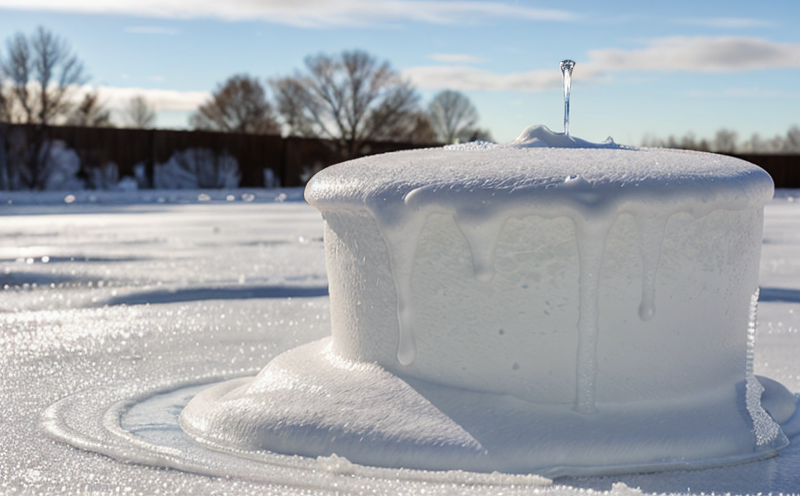SAE ARP 4736 Aircraft Ground De-Icing Operations Testing
The SAE ARP 4736 standard provides a framework for testing ground de-icing operations on aircraft. This service ensures that the safety and performance of aircraft are maintained under realistic icing conditions, which can significantly impact flight safety and operational efficiency.
Ground de-icing is critical in aviation to prevent ice formation that can compromise aerodynamics, increase weight, and reduce lift. The standard focuses on simulating real-world icing scenarios using controlled laboratory environments. This service helps operators validate their de-icing procedures and ensure compliance with regulatory standards such as FAR 91.435 and EASA CS-25.
Testing involves subjecting the aircraft to a range of ice accumulations, typically in layers or as a single block, to assess the effectiveness of various de-icing fluids and application techniques. The primary objective is to ensure that these methods are effective under the specified icing conditions without causing structural damage or compromising the aerodynamic performance.
The service covers both static and dynamic testing scenarios. In static tests, aircraft remain stationary while subjected to ice accumulation. Dynamic tests involve simulating real-world conditions where the aircraft moves through an icing environment. This allows for a more comprehensive assessment of de-icing fluids' effectiveness under dynamic flight conditions.
Testing typically involves the following steps:
- Preparation and calibration of test equipment
- Application of ice accumulations to the aircraft surfaces
- Application of de-icing fluids
- Evaluation of fluid performance through visual inspection and measurement
The service also provides a detailed report that includes:
- Test conditions and parameters
- Results from the application of various de-icing fluids
- Visual and quantitative assessments of ice removal effectiveness
- A comparison with baseline data to ensure consistency
This service is essential for aircraft manufacturers, operators, and maintenance personnel looking to ensure compliance with regulatory standards and improve safety in icing conditions.
| Test Phase | Duration | Activities Performed |
|---|---|---|
| Preparation | 1–2 days | Equipment calibration, aircraft preparation |
| Icing Application | 3–4 hours per phase | Application of ice layers or blocks to various surfaces |
| De-Icing | 1–2 hours | Application and assessment of de-icing fluids |
| Evaluation and Reporting | 4–6 hours | Data analysis, report generation |
Scope and Methodology
The scope of SAE ARP 4736 testing includes the following key areas:
- Evaluation of de-icing fluids' effectiveness under specified icing conditions.
- Determination of optimal application rates for various fluid types.
- Assessment of ice adhesion to aircraft surfaces post-de-icing.
The methodology involves a series of controlled tests, where the aircraft is subjected to specific icing conditions. The test phases are as follows:
- Icing Application: Ice layers or blocks are applied to various surfaces using an artificial ice generator.
- De-Icing: De-icing fluids are applied, and the ice is removed manually or with a specialized tool. The fluid effectiveness is evaluated by visual inspection and measurement of residual ice.
- Evaluation: Post-de-icing, the aircraft surfaces are inspected for any remaining ice. Quantitative data on the amount and location of residual ice is recorded.
The test conditions replicate real-world icing scenarios to ensure that de-icing fluids perform effectively under various environmental conditions. This includes considering factors such as temperature, humidity, and wind speed. The testing process also involves monitoring fluid performance over time to assess its durability in different environments.
Eurolab Advantages
At Eurolab, we offer comprehensive SAE ARP 4736 aircraft ground de-icing operations testing services that are tailored to meet the specific needs of our clients. Our expertise and state-of-the-art facilities ensure accurate and reliable results.
- Comprehensive Testing Capabilities: We have the capability to perform both static and dynamic tests, ensuring a thorough evaluation of de-icing fluids' effectiveness under various conditions.
- Expertise in Regulatory Compliance: Our team is well-versed with current regulatory standards such as FAR 91.435 and EASA CS-25, ensuring that our clients meet all necessary requirements.
- State-of-the-Art Facilities: Equipped with advanced ice generators and specialized tools for de-icing fluid application, we provide a controlled environment to simulate real-world icing scenarios accurately.
- Data Analysis and Reporting: Our team provides detailed reports that include all test parameters, results, and comparisons. This ensures that our clients have comprehensive data to support their decision-making processes.
We also offer additional services such as training programs for personnel involved in de-icing operations, ensuring they are well-prepared and up-to-date with the latest techniques and procedures.
Environmental and Sustainability Contributions
- Emission Reduction: By ensuring that de-icing fluids perform effectively under various conditions, we help reduce the frequency of reapplication, minimizing the environmental impact of fluid emissions.
- Resource Efficiency: The testing process helps in identifying the optimal application rates for different types of fluids, reducing waste and optimizing resource use.
- Enhanced Safety: Effective de-icing ensures that aircraft are not only compliant with regulatory standards but also safer to operate, thereby contributing positively to environmental safety.
The testing process is designed to minimize the environmental impact while ensuring the highest level of safety and performance. By adhering to international standards such as ISO 9243:2018 for de-icing fluids, we ensure that our services are both effective and environmentally responsible.





